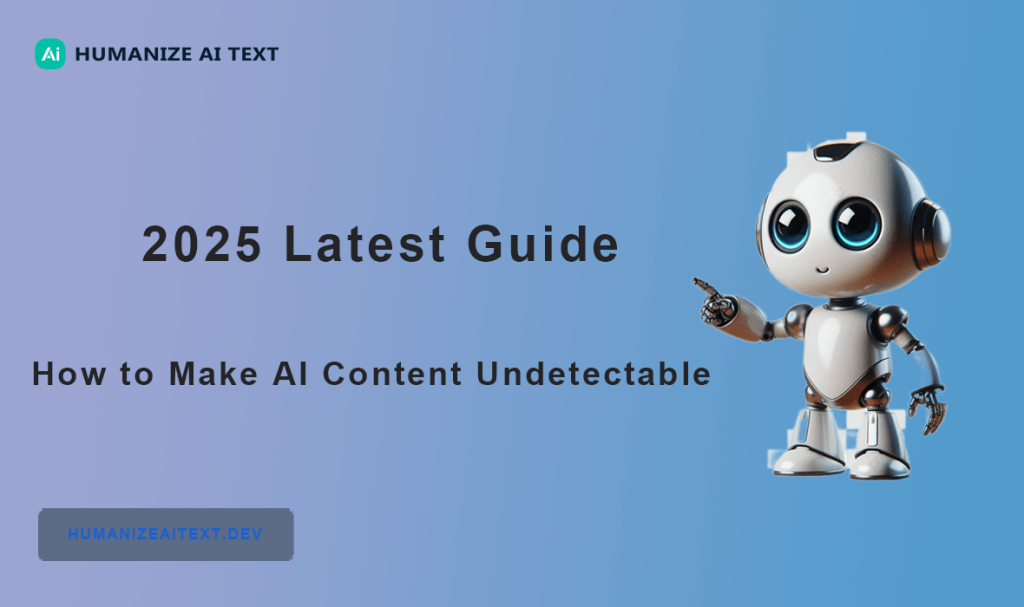Seoses selliste tehisintellektipõhiste tööriistade nagu ChatGPT, Jasper ja Writesonic kasvava populaarsusega toetuvad paljud inimesed ja ettevõtted neile, et säästa aega kirjutamisel. Üldiselt märgivad AI-detektorid, nagu GPTzero või Turnitin, selle sisu siiski masinaga loodud sisuks. Kui teid ei häiri kõrge AI-skoor teie sisus, on see täiesti okei - see juhend ei ole teie jaoks. Aga kui olete veebisisu kirjutaja või üliõpilane, kelle tööd kontrollitakse, teate täpselt, mida ma mõtlen.
Selles juhendis saate teada, kuidas muuta tehisintellekti sisu tuvastamatuks, avastades kõige tõhusamad üleskutsed, mida oleme testinud, ja usaldusväärse tehisintellekti humaniseeriva tööriista (see on tasuta).
Aega napib? Hüppa teemasse, mis sind kõige rohkem huvitab:
Kuid kõigepealt peate te teadma, miks teie kirjutis võidakse märgistada kui tehisintellekti loodud.
Miks tehisintellekti detektorid märgistavad sisu (mõnikord isegi siis, kui selle on kirjutanud inimesed):
#1 Statistilised kirjutamismustrid
Tehisintellekti detektorid kasutavad algoritme, et tuvastada tehisintellekti loodud tekstis levinud mustreid, näiteks:
- Ühtsed lausekonstruktsioonid.
- Teatud sõnavara liigne kasutamine.
- Ettearvatav sõnastus. Selliseid mustreid leidub mõnikord inimeste kirjutamises, eriti kui:
- Kirjaniku stiil on struktureeritud või korduv.
- Kirjutaja ei oska inglise keelt ja jääb lihtsate lausekonstruktsioonide juurde.
- Sisu on liigselt lihvitud ja "ohutu".
#2 Inglise keele kirjutamine, mis ei ole inglise keele emakeeleks.
Kirjutajad, kelle emakeel ei ole inglise keel, võivad tahtmatult kasutada lihtsamaid lausemustreid või formaalseid väljendeid, mis sarnanevad tehisintellekti väljunditega. Detektorid võivad seda segi ajada tehisintellekti loodud tekstiga.
#3 Sarnasus standardse AI väljundiga
Inimkirjutajad võivad tahtmatult toota sisu, mis on sarnane sellega, mida tehisintellekt kirjutab, sest nii inimeste kui ka tehisintellekti eesmärk on selgus, loogika ja järjekindlus.
#4 Vigased AI tuvastamise mudelid
Enamik tehisintellekti detektoreid tugineb tõenäosuslikele meetoditele, mis võrdlevad teksti teadaolevate tehisintellekti loodud tekstide või keeleliste mustrite andmebaasiga. Sellised detektorid tekitavad palju valepositiivseid tulemusi ja ei suuda alati absoluutse kindlusega eristada inim- ja masinkirjutust.
#5 AI-assisteeritud toimetamine
Kui keegi muudab mõõdukalt tehisintellekti loodud sisu, siis suudavad detektorid selle tuvastada, sest selle aluseks olev struktuur jääb endiselt alles. Iroonilisel kombel muudab liigne redigeerimine või püüdmine detektorit "petta" mõnikord detektorid veelgi kahtlustavamaks.
Niisiis, kuidas muuta AI sisu märkamatuks?
Kas soovite, et teie tehisintellekti sisu jääks märkamatuks? See polegi nii raske. Siin on lihtne samm-sammuline juhend, mis aitab teil muuta oma kirjutise 100% inimlikuks.
Meetod 1: Käsitsi redigeerimine (tõsiselt!)
Jah, see on ilmselge - aga lihtsalt mine sellega kaasa. See on oluline samm, sest see aitab teil veenduda, et teave on õige ja et te ei risusta saiti! Redigeerimine võimaldab teil parandada katkendlikke lauseid, parandada sakilisi üleminekuid ja leida grammatilisi vigu. Tavaliselt hõlmab see protsess järgmist:
- Parandada voolavust ja loetavust.
- Kõrvaldage klišeed või liigselt vormellikud laused.
- Kasutage selliseid vahendeid nagu Grammarly, et leida grammatilisi vigu.
(Olen lisanud selle juhendi alla rohkem kasulikke toimetamisetappe.)
Kui olete sisu toimetanud, kasutage lõpliku kontrollimiseks tuvastusvahendit. Kindlasti ei ole detektorid täiuslikud, kuid nad võivad anda teile märku kõigest, mis võib tekitada probleeme.
#1 Lisa originaalsus
Suured keelemudelid (LLM) tuginevad avalikult kättesaadavatele andmetele, reformides sageli laialt levinud fakte ja ideid. Selleks, et muuta tehisintellekti poolt genereeritud tekst vähem jälgitavaks, lisage sinna isiklikke mõtteid või kogemust. See võib hõlmata:
- Oma erialaste teadmiste jagamine.
- Uute teadusuuringute või avastuste kaasamine.
- Tsiteerides erilisi teadmisi intervjuude või koduste uuringute raames.
#2 Kasutage kõrgetasemelisi sõnu (säästlikult)
Fancy sõnad võivad teie sisu esile tõsta - kui neid kasutatakse õigesti. Lisage õigel ajal õiged erisõnad, näiteks tehniline või loominguline töö. Kuid ärge kasutage neid liigselt, lõppude lõpuks võidab alati selgus.
#3 Tee see isiklikuks
AI kipub kirjutama nagu robot (šokeeriv, eks?). Selle parandamiseks kirjutage nii, nagu räägiksite otse lugejaga. Kasutage üldiste fraaside asemel "teie" ja "teie".
Näiteks:
Selle asemel, et öelda: "Oma oskusi saab parandada harjutamisega", proovige: "Oma oskusi saab lihvida järjepideva harjutamisega."
Isikliku puudutuse lisamine muudab teie sisu kohe paremini seostatavaks - ja seda on palju raskem märgata.
#4 Ümberkorraldused lause struktuuris
Tehisintellekti saladus: ta armastab etteaimatavaid mustreid. Siis segage neid. Et seda saavutada, võiksime ka:
- Jaotage pikad laused lühikesteks, tabavateks lauseteks.
- Ühendage lühemad laused aeg-ajalt keerukamate lausetega.
- Alusta lauseid küsimuste, üleminekute ja hüüatustega.
#5 Puhastage sõnamulinad ja pehmed metafoorid
AI armastab visata sõnu nagu "revolutsiooniline" ja "mängu muutja". Kõlab muljetavaldavalt, kuid need ei anna suurt lisaväärtust. Nii et eemaldage need ja asendage need selge ja otsekohese keelega.
Ja kui te seda teete, siis kontrollige metafoore kaks korda. Kui need tunduvad pealesunnitud või ebamäärased, loobuge neist. Igatahes on parem olla otsekohene kui segadust tekitav.
Meetod 2: paluge GPT-l muuta AI sisu tuvastamatuks
Võite kasutada selliseid vahendeid nagu ChatGPT, Claude AI või sarnaseid AI-generaatoreid, et kirjutada oma väljundid ümber loomulikumalt ja inimlikumalt. Hästi läbimõeldud kohandatud üleskutse koostamine võib suunata tehisintellekti tootma vähem mehaaniliselt kõlavat sisu. Allpool selles juhendis on jagatud mõned minu soovituslikud üleskutsed - vaadake neid.
Meetod 3: Kasutage AI tekstihumaniseerija tööriistu AI detektorite vältimiseks
Platvormid nagu HumanizeAIText.dev ja muud tehisintellekti-inimese tekstikonverterid võivad aidata muuta teie tehisintellekti abil loodud sisu. Need tööriistad sõnastavad tehisintellekti kirjutatud teksti ümber, et see kõlaks loomulikumalt ja inimlikumalt, suurendades võimalusi isegi arenenud tehisintellekti tuvastussüsteemidest mööduda.
Tõestatud üleskutsed AI teksti märkamatuks muutmiseks
Liiga palju sõnu eespool, et neid töödelda? Jah. Aga see on vajalik, kui soovite õppida, kuidas muuta teksti nii, et see ei oleks AI.
Aga kuidas oleks lihtsalt mõne testitud üleskutsetega? Jah, see säästaks palju aega. Järgnevalt jagan kahte üleskutset, mille täiustamisele kulus mul paar päeva. Ja nüüd annan need teile täiesti tasuta (lihtsalt loodan, et te jagate seda postitust oma sõpradega).
Muide, ma ei väida, et need muudavad teie teksti kõigi AI-detektorite poolt tuvastamatuks või muudavad selle 100% inimlikuks, kuid need aitavad kindlasti.
Ülesanne 1 AI eemaldamiseks tekstist:
"Vaadake see materjal läbi, et leida tüüpilised AI kirjutamisstiilid ja muuta neid, et need kõlaksid loomulikumalt. Hoidke silma peal akadeemilistel sõnastustel, korduvatel lausevormidel ja liigselt kasutatud üleminekutel. Samuti eemaldage ettearvatavad mustrid ja proovige juhuslikumat lähenemist, et muuta tekst loomulikumaks. ja võtke kasutusele juhuslikum stiil. Siin on sisu: [Paste Your Content]"
Vaatame, kas see üleskutse töötab AI eemaldamiseks tekstist. Kõigepealt genereerisin testimiseks ChatGPT sisu näidise:

Nüüd panen ma selle läbi ühe AI kontrollija. Kasutan selle proovi jaoks GPTZero, mis on kõige rangem ja populaarsem detektor sisu loojate seas.

Nagu eespool näidatud, on see märgistatud GPTzero's kui 100%. Pärast seda, kui ma kasutan ChatGPT-i üleskutset, näeb uuendatud sisu välja selline:

Vaatame, kas see humaniseeritud versioon läheb GPTzero tuvastamisest mööda:

Tulemus näeb hea välja. Aga kui aus olla, siis algne tulemus oli AI-checkeri järgi üle 60%, enne kui ma mõned osad käsitsi toimetasin.
Prompt 2 AI tuvastamise vältimiseks:
Vaatame teist üleskutset:
"Sõnastage alljärgnev tekst ümber lihtsas, vestluslikus stiilis kellelegi, kellel on algteadmised (IQ 70 tase). Kasutage tavakeelt, isikupronoomi ja mitteametlikku tooni. Segage asju, lisades tähelepanu köitvaid elemente, nagu lühikesed laused, küsimused, paksud sõnad või ALL CAPS. Tehke ideed selgeks lihtsate näidete, analoogiate ja kergesti jälgitavate põhjenduste abil. "
Selle testimiseks kasutan sama tekstinäidist, mis eespool:

Nüüd vaatame, kas teine üleskutse töötab originaalversiooni täiustamiseks:

Ok, meil on ümberkirjutatud tulemused. Nüüd vaatame, kas see suudab AI-kontrollijatest mööda minna. Nii nagu Prompt 1 puhul, kasutan ma jälle GPTZero't.

Kollaselt esile tõstetud laused on märgistatud kui tehisintellekti tekst. Tundub, et teine üleskutse ei eemalda kõiki AI jälgi või GPT vesimärke. Sa pead ikkagi tegema mõned käsitsi toimetused, enne kui saad kõrge inimskoori. Kuid see vähendab mingil määral AI-protsenti.

See lähenemisviis toimib kõige paremini, kui teie sisu põhineb teie enda loodud ideedel. Kui esialgne sisu on täielikult loodud ChatGPT või sarnaste tööriistade abil, ei pruugi need üleskutsed nii tõhusalt toimida.
Lõppude lõpuks on need mõeldud lausete ja sõnade muutmiseks, mitte kogu kontseptsiooni täielikuks ümberkujundamiseks. Nagu te teate, tundub tehisintellekti loodud tekst sageli üleliigne ja puudub isiklik kogemus. Isegi kui sisu ei ole AI-detektorite poolt märgistatud, võib see lugejale ikkagi robootiliselt mõjuda. Pidage meeles, et teie publik ei ole pime.
Rohkem nõuandeid AI-detektorite vältimiseks
Oleme kokku kogunud mõned artiklid, milles käsitletakse ka juhiseid (loodame, et need on teile kasulikud), et muuta tehisintellekti tekst märkamatuks. Pange tähele, et me ei ole veel igaüht eraldi testinud.
30 üleskutset, et teha AI essee mitte AI: https://cowriter.ai/blog/ai-prompts-to-humanize-your-essay
10 Ülesanded, et AI tekst ei oleks tuvastatav: https://www.linkedin.com/pulse/10-prompts-humanize-your-ai-content-unbelievable-ways-marcus-sheridan-4uw7e
20 üleskutset, et muuta tehisintellekti sisu märkamatuks: https://mpost.io/best-20-prompts-to-humanize-ai-text-easy-to-write-human-like-articles/
Lihtsaim viis AI sisu märkamatuks muutmiseks: Kasutage AI Humanizer
Nagu me eespool mainisime, tehisintellekti humaniseerivate vahendite abil saab detektoreid petta, sõnastades GPTga kirjutatud teksti ümber, et see kõlaks rohkem nagu inimkiri. Üks neist on HumanizeAIText, mis on tasuta tuvastamata tehisintellekti tööriist.

See teisendab tehisintellekti kirjutatud teksti inimese tekstiks, lõhkudes ettearvatavaid mustreid, lisades lause struktuuri varieeruvust. Seejuures parafraseerib ta formaalseid või üldisi väljendeid, kasutab harvaesinevaid sünonüüme ning lisab vestluslikule toonile emotsionaalseid vihjeid, retoorilisi küsimusi ja kõnekeelseid väljendeid, et jäljendada loomulikku inimkirjutamist.
Kas tõesti toimib tehisintellekti teksti märkamatuks tegemine?
Me kasutame sama valimit. Vaadake:
Enne:

Humaniseeritud:

Kas AI-detektorid ei märka tulemust? Kontrollige allpool inimese tulemusi:
- GPTzero
- Kirjanik
- ZeroGPT
Lisage oma sisu siia...



Ekspertstrateegiad AI teksti märkamatuks muutmiseks
Strateegia 1: Erinevate tehisintellekti vahendite väljundite kombineerimine
Kasutage erinevaid tehisintellekti süsteeme sisu genereerimiseks ja täiustamiseks. Näiteks koostage artikkel Claude AI abil, toonige see ChatGPT abil ja viimistlege see selliste vahenditega nagu Grammarly. Erinevate süsteemide väljundite kombineerimine tagab stiili ja struktuuri mitmekesisuse, mis aitab vältida avastamist.
Strateegia 2: Isiklike kogemuste ja loomuliku tooni kaasamine
AI kirjutamine on inimlik, kui on olemas isiklik kogemus. Lisage anekdoote, isiklikke mõtteid ja isiklikke arvamusi, et muuta see seostatavaks. Vaadake lõpliku eelnõu üle, et see kõnetaks teie lugejaid ja oleks siiski reaalne.
Strateegia 3: Võtke eeskuju inimeste kirjutatud näidetest
Võtke tipptasemel inimeste kirjutatud artiklid ja laske tehisintellektil uurida nende sõnavalikuid, struktuuri ja stiili. Tehisintellekti tööriistad, nagu ChatGPT, on head kirjutamise loetavuse ja arusaamatuse tuvastamisel. Pärast analüüsimist kasutage tulemusi, et teavitada oma üleskutsetest, et luua sisu, mis sarnaneb suuresti inimtekstiga.
Strateegia 4: Muutke tehisintellekti koolitusallikaid.
Teie AI kokkupuude mitmesuguste kirjutamisstiilide ja sisuteemadega, nagu raamatud, intervjuud, esseed ja isegi stsenaariumid. See hoiab selle väljundi üllatavamana ja nüansirikkamana, sarnanedes tõelise inimväljendusega.
Lõplikud mõtted:
See juhend hõlmab kõike, kuidas muuta tehisintellekti sisu tuvastamatuks. Me uurisime käsitsi toimetamise samme, jagasime tõestatud üleskutseid, tõstsime esile mõned populaarsed artiklid üleskutse strateegiate kohta, edasijõudnud nõuandeid ja mis kõige parem, tutvustasime teile lihtsaim ja tasuta lahendus - HumanizeAIText, tehisintellekti humaniseeriv vahend.
Kui leidsid, et see juhend on kasulik, siis ära unusta seda järjehoidjatesse panna! Me uuendame seda pidevalt uute juhiste ja strateegiatega, mis aitavad teil hõlpsasti luua märkamatut AI-sisu.






